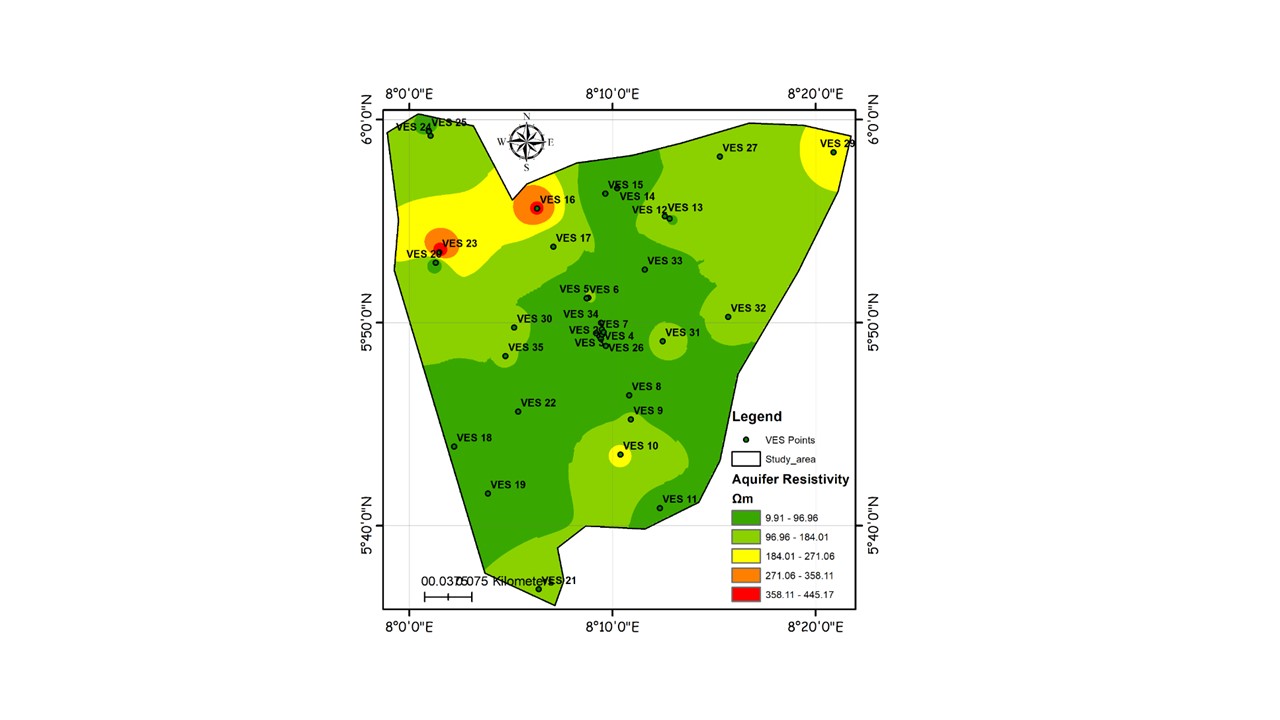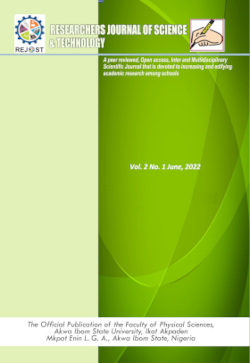Hydrogeophysical Characterization of Aquifers in Parts of Central Cross River State, Nigeria: Insights from the Ikom-Mamfe Embayment
Keywords:
Groundwater resources, aquifers, hydrogeophysical analysis, transmissivity, Central Cross River State, sustainable water managementAbstract
Groundwater is the primary source of potable water in Central Cross River State, Nigeria. This study investigates the hydrogeological and hydrogeophysical characterization of aquifers to optimize groundwater extraction in parts of the Ikom-Mamfe embayment. The research aims to evaluate the aquifer systems, address potential challenges and contamination risks limiting potable water exploration and exploitation, and propose sustainable groundwater management strategies for ensuring water availability and quality. To achieve these objectives, hydrogeological and hydrogeophysical methods were integrated to enhance groundwater exploration, mitigate contamination risks, and support sustainable water resource management. Key aquifer properties were assessed to determine groundwater availability, utilizing geophysical techniques such as Vertical Electrical Sounding (VES) and Electrical Resistivity Tomography (ERT) to delineate aquifer boundaries and identify zones with high groundwater potential. A multidisciplinary approach incorporating geophysical surveys, borehole data analysis, and GIS-based spatial mapping was employed. Field investigations at 35 VES locations identified two principal aquifer systems. The first, the Eze-Aku Sandstone aquifer, is located on the western and northwestern flanks, covering Ekori, Ugep, and most of Abi Local Government Area (LGA). The second, the Asu River Sandstone and Limestone aquifer, spans Abini, Adim, Idomi, Mkpani, Nko, Lebang, and Inyima in Yakurr LGA, as well as Ofat, Ofodua, and other parts of Obubra LGA. Substantial variations were observed in aquifer resistivity (9.5 to 446.5 Ωm), thickness (1.1 to 111.3 m), and depth (1.1 to 119.7 m). Transmissivity values peaked at 67.82 m²/day in high-potential zones, demonstrating a strong correlation between groundwater availability and geological formations. The study further revealed the presence of shallow aquifers (<30 m) and deeper aquifers (>60 m), with the latter exhibiting higher yields and better protective capacity. Emphasizing the importance of strategic groundwater management, this study recommends prioritizing deep aquifer drilling in high-transmissivity zones. The findings provide valuable insights for policymakers, hydrologists, and water resource managers, contributing to the broader goal of sustainable groundwater development in Central Cross River State.
References
Akpan A. E, Ugbaja, A. N. and George, N.J. (2013). Integrated geophysical, geochemical and hydrogeological investigation of shallow groundwater resources in parts of the Ikom-Mamfe Embayment and the adjoining areas in Cross River State, Nigeria. Environ. Earth Sci, Germany, 70 (3). 1435–1456, Doi. 10.1007/s12665-0132232-3.
Akpan, A. E., Ugbaja, A. N., Okoyeh, E.I., George, N.J, (2018), Assessment of spatial distribution of contaminants and their levels in soil and water resources of Calabar, Nigeria using geophysical and geological data, Environmental Earth Sciences, Germany, 77: 13,10.1007-/s12665-017-7189-1
Alam, J.B., Ahmed, A., & Alam M.Z. (2024). Application of Electrical Resistivity Tomography in Geotechnical and Geoenvironmental Engineering Aspect. Geotechnics 2024, 4(2), 399-414; https:/-/doi.org/10.3390/geotechnics4020022
Alley, W. M., Reilly, T. E., & Franke, O. L. (1999). Sustainability of ground-water resources (Vol. 1186). US Geological Survey.
Annan, A. P. (1989). Ground-penetrating radar for high-resolution mapping of soil and rock stratigraphy. Geophysical Prospec-ting, 37(5), 531-551.
Asfahani, J., Aretouyap, Z. & George, N. (2023) Hydraulic characterization of the Adamawa-Cameroon aquifer using inverse slope method, Water Practice and Technology, 18 (3), 547
Bassey, C. E., & Ehirim, C. N. (2018). Application of electrical resistivity and ground penetrating radar in hydrogeological studies: A case study of the Niger Delta, Nigeria. Hydrogeology Journal, 26(4), 1035-1050.
Calow, R. C. (2012). African groundwater: A hidden resource. Hydrogeology Journal, 20(1), 1-18.
Ebeniro, J. O. (2014). Geophysical investigation of aquifer vulnerability in the Niger Delta. Journal of African Earth Sciences, 97, 47-57.
Edet, A. (2004). Hydrogeochemical evolution of groundwater in southeastern Nigeria. Hydrological Sciences Journal, 49(1), 123-135.
Edet, A. E., & Okereke, C. S. (2002). Delineation of Shallow Groundwater Aquifers in the Coastal Plain Sands of Calabar Area (Southern Nigeria) Using Surface Resistivity and Hydrogeological Data. Journal of African Earth Sciences, 35, 433-443.https://doi.org/10.1016/S0899-5362(02)00148-3
Edet, A., & Esu, E. O. (1998). Hydrogeological and hydrochemical characterization of shallow coastal aquifers in the Niger Delta, Nigeria. Environmental Geology, 34(1), 123-130.
Ehirim, C. N., & Ebeniro, J. O. (2014). Geophysical investigation of aquifer vulnerability in the Niger Delta. Journal of African Earth Sciences, 97, 47-57.
Ekanem, A.M., George, N.J., Thomas, J.E., Udo, I.G., (2024) Geophysical Investigation of Aquifer Flow Unit Characteristics in Northern Parts of Akwa Ibom State, Southern Nigeria. Results in Earth Sciences, https://doi.org/10.1016/j.-rines.2024.100017
Esu, E. O. (1998). Hydrogeological and hydrochemical characterization of shallow coastal aquifers in the Niger Delta, Nigeria. Environmental Geology, 34(1), 123-130.
Fetter, C. W. (2001). Applied hydrogeology. Pearson Education.
Franke, O. L. (1999). Sustainability of ground-water resources (Vol. 1186). US Geological Survey.
Gandla, S., Umrikar, B., George, N.J. & Gupta, G. (2024) Geochemical assessment of groundwater quality for domestic, irrigation and industrial purposes: a tool for environmental monitoring and assessment in a semiarid region of eastern Maharashtra, India, Discover Water. ,https://doi.org/10.1007/s43832-024-00158-x
George N. J., Akpan A. E., Ekanem A. M. (2016). Assessment of textural variational pattern and electrical conduction of economic and accessible quaternary hydrolithofacies via geoelectric and laboratory methods in SE Nigeria: a case study of select locations in Akwa Ibom State. J Geol Soc India 88:517–528
George, N. J. A., Akpan, A. E., & Ekanem, A. M. (2016b). Assessment of textural variational pattern and electrical conduction of economic and accessible quaternary hydrolithofacies via geoelectric and laboratory methods in Southeastern Nigeria: A case study of select locations in Akwa Ibom State. Journal of the Geological Society of India, 88(4), 517–528.
George, N. J., Akpan, A. E., & Evans, U. F. (2016a). Prediction of geohydraulic pore pressure gradient differentials for hydrodynamic assessment of hydrogeological units using geophysical and laboratory techniques: A case study of the coastal sector of Akwa Ibom State, Southern Nigeria. Arabian Journal of Geosciences, 9(4), 1–13.
George, N. J., Akpan, A. E., & Obot, I. B. (2010). Resistivity study of shallow aquifer in parts of Southern Ukanafun Local Government Area, Akwa Ibom State. E-Journal of Chemistry, 7(3), 693–700.
George, N. J., Obianwu, V. I., & Obot, I. B. (2011a). Estimation of groundwater reserve in unconfined frequently exploited depth of aquifer using a combined surficial geophysical and laboratory techniques in the Niger Delta, Southern Nigeria. Advances in Applied Science Research, 2(1), 163–177.
George, N. J., Obianwu, V. I., & Udofia, K. M. (2011b). Estimation of aquifer hydraulic parameters via complementing surficial geophysical measurement by laboratory measurements on the core samples in the southern part of Akwa Ibom State, Nigeria. International Review of Physics, 5(2), 88–97.
George, N.J., Agbasi ,O.E., Umoh, A,J., Ekanem, A.M., Udosen, N.I., Thomas , J.E., Aka, M.U., Ejepu , J.S. (2025) Enhanced contamination risk assessment for aquifer management using the geo-resistivity and DRASTIC model in alluvial settings, Cleaner Water, Vol. 3, 100060, https://doi.org/10.1016/j.clwat.2024.10006
George, N.J., Ekanem, A.M., Thomas, J.E. and Ekong, S.A. (2021) Mapping depths of groundwater-level architecture: implica-tions on modest groundwater-level declines and failures of boreholes in sedimentary environs Acta Geophys., 69, 1919-1932, 10.1007/s11600-021-00663-w
George, N.J., Ekanem, A.M., Thomas, J.E., Udosen, N.I., Ossai, N.M. and Atat, J.G. (2024). Electro-sequence valorization of specific enablers of aquifer vulnerability and contamination: A case of index-based model approach for ascertaining the threats to quality groundwater in sedimentary beds. HydroResearch, 7, pp.71-85. https://-doi.org/10.1016/j.hydres.2023.11.006
George, N.J., Ekanem, A.M., Thomas, J.E., Udosen, N.I., Ossai, N.M. and Atat, J.G. (2024). Electro-sequence valorization of specific enablers of aquifer vulnerability and contamination: A case of index-based model approach for ascertaining the threats to quality groundwater in sedimentary beds. HydroResearch, 7, pp.71-85. https://doi.org/10.1016/j.hydres.2023.11.006
George, NJ; Thomas, JE. (2023) Groundwater potential and quality assessments of a coastal environment: a case study of the location of Federal University of Technology Ikot Abasi (FUTIA), Akwa Ibom State, Nigeria, Journal of Coastal Conservation 27 (4), https://doi.org/10.1-007/s11852-023-00956-w
Ghouili, N., Jarraya-Horriche, F., Hamzaoui-Azaza, F., Zaghrarni, M.F., Ribeiro, F., Zammouri, M.(2020) Groundwater vulnerability mapping using the Susceptibility Index (SI) method: Case study of Takelsa aquifer, Northeastern Tunisia J. Afr. Earth Sci., 173, Article 104035, 10.1016/j.jafrearsci.2020.104035
Ibuot, J.C., Obiora, D,N., George, N.J (2024) Evaluation of geohydraulic response properties of hydrogeological units in Littoral hydro-lithofacies in Uyo, Southern Nigeria, Appl. Water Sci., 14 (2024), p. 9, 10.1007/s13201-023-02057-3
Inim I.J., Udosen N.I., Tijani M.N., Afia U.E., George N.J. (2020) Time‑lapse electrical resistivity investigation of seawater intrusion in coastal aquifer of Ibeno, Southeastern Nigeria, Applied Water Science, Germany, 10, 232 (2020), https://doi.org/10.1007/s13201-020-01316-x
Jolly, J., Ndlovu, L., & Gumede, H. (2015). Electrical resistivity and hydrogeophysical characterization of groundwater resources in South Africa. Groundwater, 53(5), 725-739.
Kumar, D., Kundu, R., & Venkatesh, A. S. (2018). Integrated geophysical investigation for aquifer delineation in India’s arid regions. Environmental Earth Sciences, 77(15), 528.
Loke, M. H. (2004). Tutorial: 2D and 3D electrical imaging surveys. Advanced Geosciences, Inc.
MacDonald, A. M., Davies, J., & Calow, R. C. (2012). African groundwater: A hidden resource. Hydrogeology Journal, 20(1), 1-18.
Nyquist, J. E., & Corry, C. E. (2002). Ground penetrating radar in hydrogeological studies. Groundwater, 40(4), 438-444.
Obianwu, V. I. George, N.J. and Okiwelu, A.A. (2011). Preliminary Geophysical Deductions of Lithological and Hydrological Conditions of the North-Eastern Sector of Akwa Ibom State, South eastern Nigeria. Research Journal of Applied Science, Engineering and Technology, Maxwell Science Organization, NY, 11230, 3 (8): 806-811
Obiora D.N., Ibuot, J.C., George N.J, Solomon U. O. (2016): Delineation of Groundwater Saturation Indicators and their Distributions in the Complex Argillaceous Geological Units of Ezzra North Local Government Area of Ebonyi State, Nigeria, Journal of current Science, Vol.110, NO. 4, doi: 10.18520/cs/v110/i4/701-708.
Obiora, D.N., Ibuot, J.C., and George. N.J. (2015). Geophysical assessment of potential hydrological units in hydrologically challenged geomaterials of Makurdi, Benue State, Nigeria. International Journal of Physical Sciences, Malaysia, 10(16) 479-489, DoI:10.5897/IJPS2015.4386.
Olasehinde, P. I. (2010). Hydrogeological studies and groundwater exploration in the basement complex terrain of Nigeria. Journal of Applied Sciences and Environmental Management, 14(1), 5-10. s10661- 020- 08436-6.
Sheriff, R. E. (1990). Applied geophysics. Cambridge University Press.
Telford, W. M., Geldart, L. P., & Sheriff, R. E. (1990). Applied geophysics. Cambridge University Press.
Thomas J. E., George N. J., Ekanem A. M., Nsikak E. E. (2023). Electrostratigraphy and hydrogeochemistry of hyporheic zone and water-bearing caches in the littoral shorefront of Akwa Ibom State University, Southern Nigeria. Environ Monit Assess., 192:505. https:// doi. org/ 10. 1007/
Udosen, N.I., Ekanem, A.M. and George, N.J., Thomas J. E. (2024b) Geo-electro-stratigraphic assessment of aquifer potential, protectivity, and pliable level of vulnerability within a coastal milieu, Water Practice & Technology, 19 (5), doi: 10.2166/wpt.2024.125
Udosen, N.I., Ekanem, A.M. and Thomas, J.E. (2024a). Geo-hydraulic characterization of a coastal aquifer system in South-eastern Nigeria with the inverse slope method. Researchers Journal of Science and Technology, 4(1), pp.1-20.
Umoh, J, A., George, N.J., Ekanem, A.M., Thomas, J.E., Emah, J.B. (2022) Approximate delineation of groundwater yield capacity and vulnerability via secondary geo-electric indices and rock-water interaction hydrodynamic coefficients in a coastal environment. Researchers Journal of Science and Technology, 2(3), 28-54
Uwa, U.E., Akpabio, G.T. & George, N.J. (2019). Geohydrodynaic parameters and their implications on the coastal conservation: A case study of Abak Local Government Area (LGA), Akwa Ibom State, Southern Nigeria, Nat Resour Res., Switzerland, 28(2), 349-367, https://doi.-org/10.1007/s11053-018-9391-6
Venkatesh, A. S. (2018). Integrated geophysical investigation for aquifer delineation in India’s arid regions. Environmental Earth Sciences, 77(15), 528

Downloads
Published
How to Cite
Issue
Section
License
Copyright (c) 2025 Researchers Journal of Science and Technology

This work is licensed under a Creative Commons Attribution-NonCommercial-NoDerivatives 4.0 International License.




